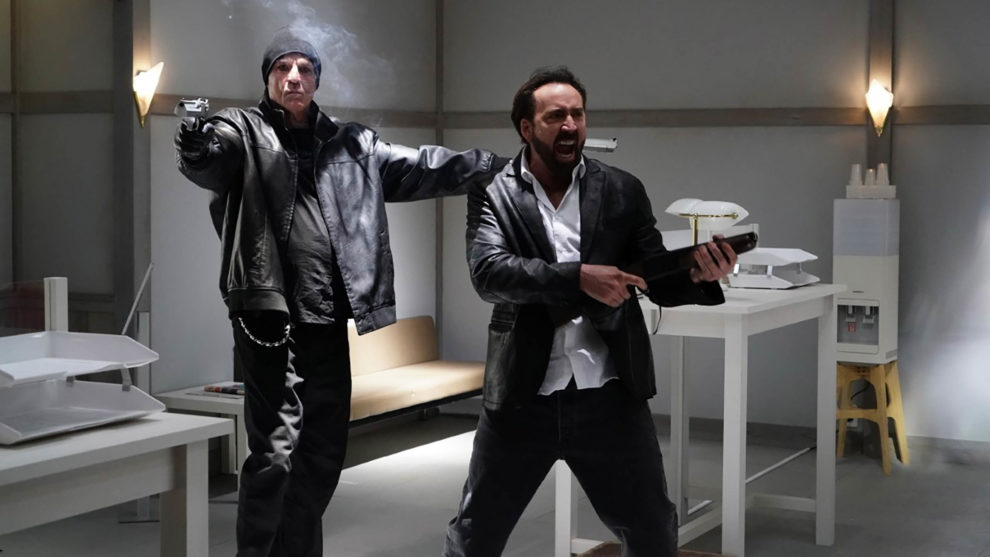Half-naked and bleary-eyed, Hero (Nicolas Cage) is surrounded in Samurai Town. He looks to the left: all cowboy gunmen, outflanked by wary samurai. He looks to the right: dolled-up geishas croon at him from afar. So he looks ahead: Governor (Bill Mosely), clad in a pristine white suit, sneers back at him. This is Hero's mission, he realizes: he needs to get the hell out of here.
Prisoners of the Ghostland is screening at Sundance

This scene totally encapsulates the craziness of Sion Sono's hotly-anticipated whack-o epic, “Prisoners of the Ghostland.” Sion Sono's first English-language film — starring Nicolas Cage in a Samurai-Western-post-Nuclear fallout fantasyland — premiered at Sundance on Sunday night. Though the premiere was strictly online, applause was no less muted; critics on on Twitter, Letterboxd, and even Whatsapp press chats gave the film glowing reviews.
“Prisoners of the Ghostland” follows the redemption story of Hero, an ex-convict. After getting caught for a violent bank robbery with his partner Psycho (Nick Cassavetes), Hero winds up in Samurai Town, a kitsch-y mix of Edo-period architecture outlined in neon. The white-capped, corrupt Governor promises to free Hero as long that Hero can fetch the Governor's long-lost daughter Bernice (Sofia Boutella) from the Ghostland — a colonized purgatory of the living, the undead, and the actual dead. Crucially, Governor zips up Hero in a leather bodysuit bound with explosives. This bodysuit — complete with bombs strategically placed on the neck, arms, and testicles — threatens to explode entirely if Hero does not finish his mission in five days. Set with the time pressure of a heroic epic and the crassness of filmic mockery, Sono pulls out all stops to tease out the vulgarity of American media in his newest film.
Sono's biting political commentary lays it own thick, as he reconsiders images of Japan in American eyes. Samurai Town exhibits an exoticized Japan to the extreme; samurai fight exclusively under bursts of sakura petals, and kimono-clad geisha giggle at passerby in wood-panelled windows. Ghostland, on the other hand, envisions an international Japan ravaged with anti-American sentiment after a tragic nuclear incident. Visible representations of a mushroom cloud prevail, and victims of the said fallout — including “Train to Busan”-esque zombies and Psycho (Nick Cassavetes) — approach Hero with their skin virtually melted off. And of course, Sono does not forget to include the sheer capitalistic postwar drive. Geisha fawn over the Governor when he “makes it rain” American dollars; Nicolas Cage's getaway car is a sturdy Toyota. And of course, hints to the current America are plastered upon the posters – including slogans like “Make this Country Great Again.” In these elaborate sets, the delectable details deliberately overstimulate to embody kitsch to the extreme.
When it comes to kitsch, Cage could not be a better fit. As the meme face of starring as “everyone in everything,” Cage clearly lives up to his role as the generic Hero. He is nothing and everything all at once in the film. He is a stoic samurai one scene, and a haphazard insurrection leader the next; he captures the full range of a self-absorbed convict to a criminal with a conscience. Cage's stylized acting only complements the stilted acting of the other English-language professionals (Mosely's in particular). The awkward naturalism feels fitting, only further contributing to the film's campy vibe.
In this clash of East versus West, perhaps the only complaint is that Sono's film is a bit too stimulating. The viewer is apt to lose themselves in the richness of each individual frame, and the pacing of the film feels as frenetic as it does flamboyant. In a manner similar to storied labyrinths of the French New Wave, what would be a linear tale buries its “checkpoints” under an avalanche of satirical detail. This in addition to the deadpan humor of the 90s sitcom (“The Office” in particular comes to mind) can preoccupy the unwary viewer when caught off-guard.
All in all, “Prisoners of the Ghostland” ultimately presents a wildly irreverent tribute to cinema. Ghosts haunt “Prisoners of the Ghostland” indeed – or at least, the ghosts of pop culture are jam-packed into each frame for all 103 minutes. It will just take one – or maybe two, or maybe three – rewatches to see them all, is all.















